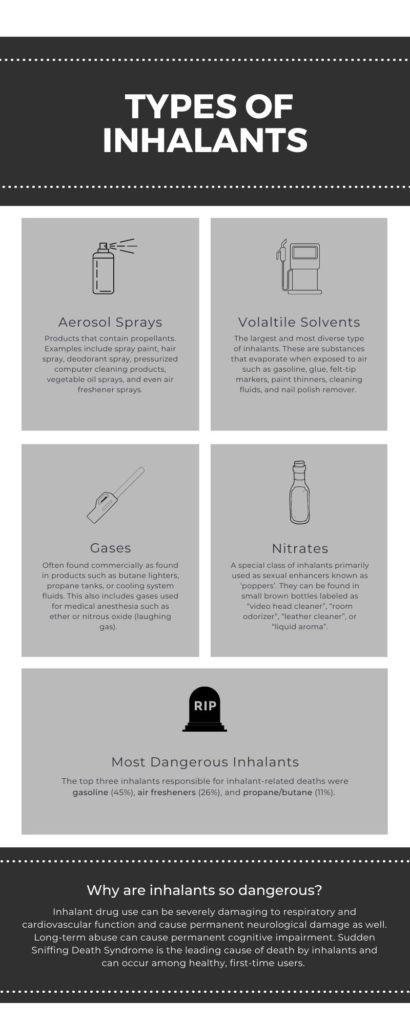Inhalants are a type of drug favored by adolescents–and you probably have quite a few of them laying around. Many of which are common household items you’d have never thought twice about: your hair spray, an air freshener, even vegetable oil spray in your kitchen. Despite how readily available (and legal) these products are, they have tremendous abuse potential and can result in a number of adverse health effects including addiction. The third week of March is nationally recognized as National Inhalants & Poisons Awareness Week to highlight the potential dangers of these substances and prevent unnecessary tragedies.
What Are Inhalants?
Inhalants are gaseous or vaporous substances that produce a high when breathed in. They contain psychoactive properties which rapidly induce feelings of euphoria, stimulation, or disinhibition. It is these mood-altering effects that have made them a popular target for abuse.
Inhalant drugs act as depressants. Their effects on the body are similar to that of benzos, barbiturates, or alcohol. A variety of types of neurotransmitters are affected when an inhalant is ingested, many of which affect the central nervous system.
Naturally, inhalant drug use can be severely damaging to respiratory function. However, that is not the only type of damage inhalants inflict on the body. They also have major cardiovascular side effects. In fact, cardiac arrhythmia (known as ‘sudden sniffing death syndrome’) is the leading cause of death by inhalant users. One study with over half a million teenage participants found that 22% of those who died of this syndrome were first-time inhalant users. Inhalants can also cause lasting neurological and psychological damage which can impair motor and cognitive and sensory functions.
Types of Inhalants & Examples
Many inhalants are common household products such as hairspray or gasoline and are relatively inexpensive and easy to acquire. Their accessibility has made inhalants one of the few drugs that are primarily targeted by younger individuals and have become a major issue of concern. There are hundreds of different types of inhalants, most of which fall under four main categories. Street names of inhalants can vary depending on this classification.

Aerosol Sprays
Substances that contain propellants and may also have solvents, pressurized liquids, or gases. These include a wide range of consumer products ranging from personal grooming to cooking products. These include spray paint, hair spray, deodorant spray, pressurized computer cleaning products, vegetable oil sprays, and air freshener sprays.
Gases
Many of these forms of inhalants can be found in commercial products such as butane lighters, propane tanks, or cooling system fluids. Other forms include chloroform, ether, and nitrous oxide (referred to as ‘whippets’) which are used for medical anesthesia purposes.
Nitrates
A special class of inhalants primarily used as sexual enhancers known as ‘poppers’. There are both organic and synthetic nitrites that have legitimate use. They are often sold in small brown bottles labeled as “video head cleaner”, “room odorizer”, “leather cleaner”, or “liquid aroma”.
Volatile Solvents
These are substances that dissolve in other substances and evaporate when exposed to air. Types of volatile solvents include gasoline, glue, felt-tip markers, paint thinners, cleaning fluids, and nail polish remover. These are sometimes referred to as ‘glue’, ‘gas’, or ‘sniff’.
The top three inhalants responsible for inhalant-related deaths were gasoline (45%), air fresheners (26%), and propane/butane (11%).
Different Forms Inhalant Abuse
Depending on the type of inhalant, the way of using one and the specific name that it’s called can vary as well. Huffing is one of the most widely known methods of using an inhalant. It involves holding a rag or cloth saturated with the substance over one’s mouth or nose. This is sometimes combined with a method called ‘bagging’ which involves using a plastic or paper bag to maintain stronger concentrations of the substance. These two methods result in the strongest high and are the most popular.
Other methods of inhalant abuse are ‘sniffing’ or ‘snorting’, which is simply direct inhalation. ‘Glading’ is the term used specifically regarding the inhalation of air freshener aerosols while ‘dusting’ refers to spraying aerosol cleaners directly into the nose or mouth.
Are Inhalants Addictive?
Yes, inhalants can be addictive, result in withdrawal, and even cause overdoses. Addiction is not common, however, any substance that affects neurotransmitters carries the potential to result in a substance use disorder. Withdrawal symptoms are mild and can resemble that of an illness: nausea, loss of appetite, sweating, difficulty sleeping, and mood changes.
An inhalant overdose is very possible, as many of the solvents and aerosols are highly concentrated which makes them dangerously potent. It can cause seizures, coma, suffocation, or heart failure–even from just a single-use. There are currently no medications available for the treatment of inhalant overdoses.
Who Is Using Inhalants?
Inhalant abuse is greatest among children and adolescents between the ages of 10 and 16 (pre-teens in particular) which has led to a perception that inhalants are a “kid drug”. While abuse does happen among adults, it is much more predominant amongst a young demographic. One study found that 66% of participants first used an inhalant when they were younger than 12. Over 22 million Americans over the age of 12 have reported using inhalants at least once in their life.
The following circumstances can significantly increase the likelihood of youth engaging in such behavior:
- Live in a rural community
- Dropped out of school
- Victim if physical or sexual abuse
- Has been incarcerated
- Has been (or is currently) homeless
- Has poor-self esteem
- Has suicidal thoughts or other psychiatric conditions
- Has unstable family life or dynamic
Being that the majority of inhalant drug users are young, such behavior can cause significant social dysfunction that’s more harmful than what might occur in adult drug users.
Detecting Inhalant Abuse
Due to how accessible (and legal) inhalants are, it can be difficult to control rates of abuse. Harder still is detecting inhalant abuse. The euphoric and depressant effects wear off almost as quickly as they occur; these are regular, everyday items and both cheap and accessible; it only takes a small amount to induce a high; there are multiple ways to use these substances. Detection is easier among chronic inhalant abusers who can develop distinctive signs that they are using:
- Strange odor on the breath
- Stains on skin or clothing
- Dryness or infection around the mouth
- Huffer’s rash
- Irritability, mood swings, or confusion
- Wheezing, shortness of breath, or lung disease
- Lack of coordination
- Tremors
- Rapid lateral eye movements
- Bloodshot eyes
- Poor appetite/Weight loss
- Nosebleeds
- Muscle weakness
- Nausea or gastrointestinal problems
Close behavioral monitoring is the best way to determine if someone is huffing or using inhalants in any form or inappropriate manner. The metabolites that make drug testing for other types of drugs possible aren’t detectable by urine or other types of laboratory drug testing. The lack of formal detection methods makes prevention the best way to approach inhalant abuse and makes education on the subject incredibly important.
Sources:
https://www.ncbi.nlm.nih.gov/pmc/articles/PMC2948777/
https://d14rmgtrwzf5a.cloudfront.net/sites/default/files/inhalantsrrs.pdf

